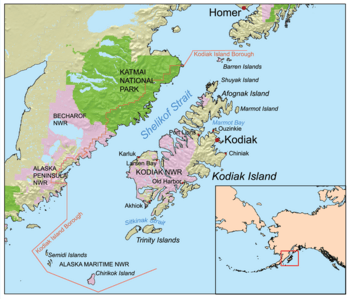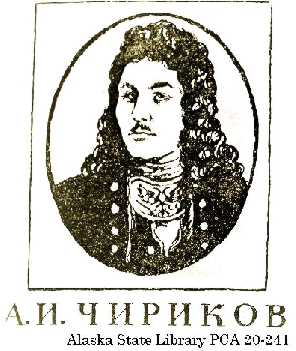Chirikof Island facts for kids

Kodiak Island map showing Chirikof Island
|
|
| Geography | |
|---|---|
| Location | Pacific Ocean |
| Coordinates | 55°49′30″N 155°37′19″W / 55.82500°N 155.62194°W |
| Archipelago | Kodiak Archipelago |
| Area | 114.787 km2 (44.320 sq mi) |
| Highest elevation | 300 m (1,000 ft) |
| Highest point | Highest Point |
| Administration | |
|
United States
|
|
| State | Alaska |
| Borough | Kodiak Island |
Chirikof Island is a unique island in the Gulf of Alaska. It is located about 80 miles (129 km) southwest of Kodiak Island. This island is known for its wild cattle and interesting history.
Contents
What is Chirikof Island Like?
Chirikof Island covers about 33,000 acres (13,355 hectares). It is mostly covered in grasses and sedges, which are like grassy plants. There are no trees on the island.
Island Shape and Surroundings
The island looks a bit like a duck's webbed foot. The "heel" part is to the north, and the "webbing" is to the south. The waters around Chirikof can be dangerous for ships. Many shipwrecks have happened there. The south shore has a wide beach. This beach is good for planes to land and for boats to approach carefully.
Visiting Chirikof Island
Anyone can visit Chirikof Island. However, large commercial boats or planes need a special permit. Personal planes or boats do not need a permit to visit.
Who Lived on Chirikof Island?
People have lived on Chirikof Island for a very long time. The first known people were called the Old Islanders. They lived there between 4,000 and 2,000 years ago. A small village existed on the island until the late 1800s. After that, people started raising foxes and then cattle.
Current Inhabitants
Chirikof Island has almost always had people living on it. There were only short times when it was empty. In 1980, the island became part of the Alaska Maritime National Wildlife Refuge. Today, the only "inhabitants" are a herd of about 700 to 800 wild cattle. These cattle have been on the island since the late 1800s.
How Did Chirikof Island Get its Name?

In 1741, two Russian captains, Vitus Bering and Alexei Chirikov, sailed near the island. Their maps called the island Tummenoi, which means "foggy" in Russian. Bering's ship saw the island on August 2, 1741. This day was St. Stephen's Day, so Bering renamed it St. Stephen Island.
Renamed by George Vancouver
Alexei Chirikov never actually saw the island himself. His ship had separated from Bering's earlier in their journey. However, in 1794, another explorer named George Vancouver renamed the island Chirikof Island. He felt that Captain Chirikov's hard work in exploration should be remembered. The native Alutiiq people of the area still call the island Ukamok (ooo-KA-mok). This name comes from the ground squirrels that are common there.
Russian Influence on the Island
In 1799, the Russian-American Company was given permission by the Russian ruler, Tsar Paul I, to manage Alaska. They also managed the resources there. The company had already set up a settlement on Kodiak Island.
Life During the Russian Period
During the time Russia controlled Alaska (from the 1740s to 1867), about 60 to 100 villagers lived on Chirikof Island. They lived by hunting and gathering food. These villagers were a mix of Alutiiq, Tlingit, Russian, and Western European people. They had a small Russian Orthodox church. The village was left empty after the only priest on the island was called back to Kodiak in 1870.
American Ownership and Cattle Ranching
When Russia sold Alaska to America in 1867, the Alaska Commercial Company took over the Russian-American Company's properties. In 1887, a part of this company started raising blue foxes on Chirikof. They even brought small rodents called voles to feed the foxes.
Cattle Arrive on the Island
A small group of cattle was brought to the island to feed the American caretakers. These caretakers did not like eating seal meat. Over time, more cattle were brought to the island. The cattle were simply driven overboard from ships and swam to shore. Once on the island, the cattle grew well on the rich grasses. They also became wilder. They do not stay in herds, and they might charge at horses or people. If they get scared, they might even run into the sea and swim until they feel safe.
The Beef Industry on Chirikof
Raising cattle for beef became a serious business on Chirikof in 1925. It continued until at least 1983. The idea for this business came from a man named Jack McCord. He formed the Chirikof Cattle Company. He worked from 1925 to 1950 to build a successful beef business. However, it was a very difficult business. There were shipwrecks, plane crashes, and problems with the wild cattle. It was hard to sell the beef from this distant island. Ranch workers have said the meat was very tough.
Chirikof Island as a Wildlife Refuge
In 1971, the Alaska Native Claims Settlement Act changed some land ownership in Alaska. In 1980, Chirikof Island became part of the Alaska Maritime National Wildlife Refuge. This means the island is protected for wildlife.
Protecting Native Species
The plan for the refuge is to help the island's native plants and animals grow back. This means the wild cattle need to be removed. The cattle eat too much of the land's plants and harm the places where birds live. In 2003, there was an attempt to remove some cattle. However, some animals were hurt during this process. This caught the attention of groups like the Humane Society of the United States. Legal issues have also slowed down plans to remove the cattle. The goal is to restore the island as a safe place for birds.

